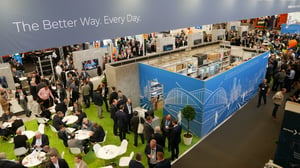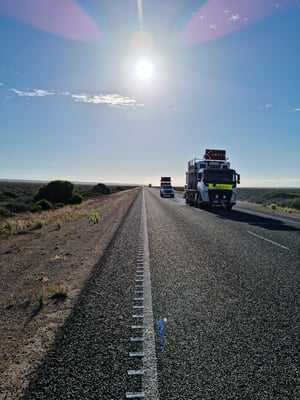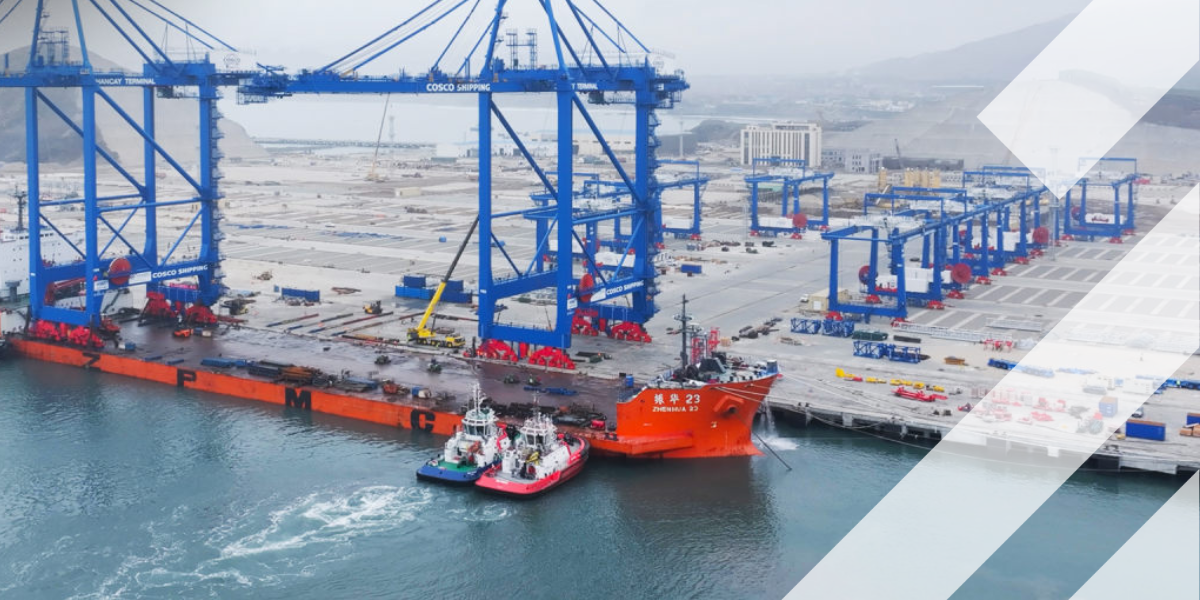SWARCO are one of the most well-known and visible companies in the traffic management sector. Attendees of various Intertraffic shows over the last couple of decades will be familiar with the Austrians’ vast and multiple exhibition stands that are notable as much for the constant number of visitors as they are for their welcoming designs and bright displays (not to mention the always excellent coffee).
However, over the last 15 years or so Austria’s SWARCO AG has transformed from being a company known for its innovative use of tiny microspheres as reflectors in road markings to arguably the most influential traffic management specialists in the world. Some, however, would argue that they have achieved this elevated status due to an expertly executed decade-and-a-half of acquisitions of ITS-adjacent firms that has seen SWARCO vacuum up several dozen business entities from San Diego to Basingstoke and fold them gently into the “family” business that now has a 10-digit annual turnover.
Clearly, purchasing a whole raft of companies that could otherwise be seen as competition is a virtually failsafe method of maintaining your position at the top of the traffic management league, but there is much more to the story of Wattens-based SWARCO AG’s success than simply identifying and acquiring companies that could add to your business portfolio. The tale here is how the firm have done it to such a successful degree that not only are they growing in every sense exponentially year on year, the company’s adherence to best practices have led to it being viewed as a genuine industry thought leader. That doesn’t happen just by swallowing up globally disparate business concerns in a random fashion. This has been an incredibly smart series of purchases, carried out with almost military precision but with a friendly, yet corporate smile on its face.
This has been an incredibly smart series of purchases, carried out with almost military precision but with a friendly, yet corporate smile on its face
Talking of faces, one of the most familiar faces on a SWARCO exhibit hall stand for the last 28 years has been Senior Communications and Event Manager, Richard Neumann. Preparing for his 14th Intertraffic Amsterdam, Richard took time out of his relentless schedule to talk about what it is that makes SWARCO a genuine smart mobility thought leader.

“My history with SWARCO goes back to 1995 and in those days we were widely known as a company in the business of road marking systems. It was only in 2003 when SWARCO entered the traffic management sector when we acquired companies in Scandinavia,” he explains.
“For context, in 1986 we first entered what is now the ITS market by buying Futurit, a company that produced traffic lights. Once you are in the traffic light business, you logically then want to be in control of the traffic lights. And that's why we expanded into the traffic control business. Today SWARCO has grown into a true technology corporation in the road safety and traffic management industry and turnover-wise traffic management accounts for two thirds of our revenue and road marking systems accounts for the other third.”
A BIG GREEN DEAL
Of the many innovative new initiatives and solutions that Neumann and SWARCO have seen the ITS sector develop (and played a significant part in), the one that has been perhaps more keenly felt than any other is the rise of sustainable mobility. With the European Green Deal high on corporate agendas all over the continent, it’s clearly of huge importance for the company to be seen as one of the leading sustainability movers and shakers.
“We introduced our Go Green initiative at the ITS European Congress in Lisbon earlier this year. It actually has a link to Intertraffic, as between May this year and when the show starts in April next year we want to get in touch with as many cities who have committed to the European Green Deal as possible. The European Green Deal means that these cities want to be Climate Neutral by 2050 and that they want to reduce their greenhouse gases by 2030 to 55% of the level they had in 1990,” Neumann explains.

“We all know that the transport sector accounts for something like 20% of the total greenhouse gas emissions around the globe. We have created a virtual reality experience in which you can dive into a 3D world in which you'll see how SWARCO can help cities with intelligent traffic management solutions, to reduce emissions to keep traffic flowing, to have an improved parking situation in the city and to provide better solutions for vulnerable road users.”
The European Green Deal means that these cities want to be Climate Neutral by 2050 and that they want to reduce their greenhouse gases by 2030 to 55% of the level they had in 1990

To date, 112 cities in Europe have committed to the European Green Deal.
“We have met cities such as Warsaw, Rome, Trondheim, Seville, Athens, and there are many more on the list. By the time Intertraffic Amsterdam comes around in April we want to have a complete picture and have reached many more cities and introduce them to our solutions, but also learn from them because it's always good to be in direct touch with city officials and address their pain points.”
As for the implications of those goals not being reached – Neumann is fully aware that the smart mobility sector is under increasingly intense pressure to ensure that that scenario is not even in the conversation.
“It’s very difficult to predict the future and 2050 is still quite far away, but nevertheless we have to start doing something, we have to change our behaviour and address the issue of climate change. It’s high time to do so. I am not aware of any punishment scenarios if you don't reach the goals, but it's a fact that with all the legislations coming from the European Union with a new taxonomy, and with sustainability reports you have to comply with, there is a lot of pressure in this sector now.”
HORIZONS EXPANDED
In keeping with SWARCO’s expansion into newer markets, the company has also significantly grown geographically as it is now, through acquisitions, present on every continent (other than Antarctica at the time of writing) after the purchase of a road marking services company in Australia.
“Although we have a presence in something like 80 countries around the globe, we are still very successful with the products we were initially known for, such as glass beads, LED traffic lights and variable message signs. But SWARCO offers more and more turnkey solutions, because our customers asked for complete solutions that involve not only hardware, but also software. This means we can solve problems like congestion, air pollution and parking problems, which in general improve the flow of traffic.”
We can solve problems like congestion, air pollution and parking problems, which in general improve the flow of traffic

SWARCO'S MILESTONES
In an industry that’s all about data there are two numbers that currently have a great deal of significance for SWARCO and its long-serving German-born spokesperson.
“Firstly we have doubled our global staff since 2014 and the company now employs 5500 traffic experts. And, we are very proud of having passed the €1 billion threshold in revenues in November 2022. In 2014 we had a turnover of something like €500 million and today it’s €1.1 billion. We are in a very strong world market position in road marking systems and also ITS. We continue to live and work in the entrepreneurial spirit of our founder Manfred Swarovski. What he gave to us during his life in SWARCO is in our DNA.”
As anyone in business or sport will tell you, even if you haven’t asked, getting to the top is difficult but staying there is even more of a challenge. If you're number one you can't go any higher, so where does the inspiration to stay there come from? How do you ensure that you don't somehow lose focus for a second (a “business second”) and allow a competitor to nip in and take the top spot? Without giving any trade secrets away, how does SWARCO go about maintaining its position at the top of the tree, so to speak?
We continue to live and work in the entrepreneurial spirit of our founder Manfred Swarovski. What he gave to us during his life in SWARCO is in our DNA
“We have to earn our leading position every day. The basis for this is competent people who are forward thinking, who are recognising trends, who are in close touch with our customers and know what their wishes are, and see what the development goals are. Innovation is a core value of SWARCO and our innovation spirit is key to being ahead of the competition and to be the number one and to continue to be the number one,” insists Neumann.
As alluded to earlier, it’s not all about Hoovering up the competition and adding the SWARCO logo to their business cards and website.
“Acquisitions are fine, of course,” he maintains, “but you also have to have the capability to integrate the new arrivals into the SWARCO corporate culture. This is not simply done by rebranding, but being part of our corporate culture with all the values we have, takes a little longer. You need to have a certain degree of patience – SWARCO has always has had the courage to develop new markets. We are now patiently trying to find new businesses in Central Asia, Africa and Latin America.”
Neumann’s mention of the company’s culture is no throwaway comment as SWARCO prides itself on being a family business, albeit one with a 10-digit turnover. The cordial atmosphere of its expo stands is a microcosm of its equally welcoming headquarters, nestled at the foot of the Austrian Alps, offering stunning mountain views from virtually every window.
“The welcoming atmosphere is part of the culture, and of course we have our big showroom, SWARCO Traffic World, where we receive visitors every day,” he begins, “but a much bigger factor is that our people have a hands-on mentality, we go the extra mile for our customers. We have a set of values such as innovation, agility, cooperation and passion. There's a lot of passion in what we do. We have a lot of people in our group who have been with the company for over 20 years. There is a big emphasis on loyalty among our staff to the company. I think this is what makes SWARCO successful. If you get entrusted with money, because you are responsible for a budget within the company, you are encouraged to treat it as if it were your own money. It’s a matter of trust and fortunately we are able to rely on many long-term customer relations, and by that I mean 30 or 40 years in some cases. That, I think,” he says, “is unique in our industry.”
There's a lot of passion in what we do. We have a lot of people in our group who have been with the company for over 20 years. There is a big emphasis on loyalty among our staff to the company
THE TIMES THEY ARE A-CHANGING
Anyone who has been involved in the same industry since the 1990s (particularly a tech-driven one) has lived through some incredible changes, many of them all-but unimaginable at a time when most of us were only just getting to grips with the wonders of email and clouds were fluffy-looking masses of water droplets or ice crystals suspended in the atmosphere.
Intertraffic asked Neumann, 60, what he considered to be the biggest change that he has witnessed since stepping wide-eyed into the traffic arena.
“Over the years things change, of course,” he answers, matter-of-factly. “If you go to exhibitions nowadays, you'll see that the stands no longer feature anywhere near as much hardware as they used to. There are a lot of TV screens and the presentation of software as it is not so easy to show complete solutions which is what everyone is now offering.
“Having said that, I would say that digitalization is the biggest change over the past decade and specifically the introduction of “the cloud”. Traffic management is now highly digitalized. Licence plate recognition systems in car parks or air quality parameters are examples of traffic sensor data that go into the cloud. And of course,” he takes a breath, “AI.”
It’s all but impossible to have a conversation about smart mobility at the tail of 2023 without the topic inevitably turning to Artificial Intelligence, as we have just evinced.
“Now AI is a big notion and you meet it literally everywhere. It’s something that we are using already because it's part of our traffic guidance systems where data fusion algorithms harmonise the output of heterogeneous data sources,” he explains. We use AI, for instance, in making the chauffeur shift schedules for public transport systems. You can also use AI-based tools to generate software code, or correct it, and even create content. Some people are afraid of AI and believe it’s going to deprive them of their jobs but I don't think that my job in corporate communication is in any imminent danger! AI will develop further and the important thing is to embrace it and use it in a responsible way.”
AI is something that we are using already because it's part of our traffic guidance systems where data fusion algorithms harmonise the output of heterogeneous data sources
THE HISTORY OF SWARCO
If it were possible to turn back time (as so desired by Cher in 1989), Intertraffic asks Neumann to imagine that it’s 2013: where did he envisage the ITS sector would be in 2023? Is it where he thought it would be… and if not, why not?
“If you look back 10 years we were identifying topics like V2X. This was supposed to be the precursor to widescale deployment. Also big data was a big topic without anybody really knowing how to monetize it and there was a lot of talk about startups arising in our sector. Now, though, I have the feeling that the ITS sector is quite stable but still very traditional. Things are not moving as fast as they should be,” he opines. “If I have a look back at all the congresses and tradeshows I have attended over the past 20 years a lot of the developments and innovations came out of EU-funded ITS projects… and we are actually not too much further along in this respect.”
Talking of tradition, Neumann fully understands that not every customer of SWARCO’s is able to replicate his company’s programme of relentless innovation, and for a variety of reasons.
“We are dealing with very traditional customers,” he says, sagely.
“And these customers sometimes lack the budget to invest in new ITS solutions, and they also have limited human resources. This is entirely understandable but means that the process of change in our industry is a very lengthy one. I have one example that I always tell when I conduct SWARCO Traffic World tours. In 2000 we launched the first LED traffic light with a central light source and this started the process of converting conventional light sources like incandescent bulbs and halogen lamps to LEDs. This process is still ongoing, 23 years later.”
In 2000 we launched the first LED traffic light with a central light source and this started the process of converting conventional light sources like incandescent bulbs and halogen lamps to LEDs. This process is still ongoing, 23 years later
After more than a quarter of a century in the traffic technology sphere, it’s hard to imagine that there is much that Neumann and his colleagues haven’t witnessed first hand. With all that knowledge and experience in the “bank”, it’s refreshing that he still sees a career in this ever-evolving sector as something he would gladly endorse and encourage.
“I would absolutely recommend starting a career in advanced traffic management. For example, there are special courses you can take at the Technical University of Munich or at Donau University in Krems in Austria, where you can become a telematics engineer,” he explains. “And I would certainly recommend it because we are working in a very interesting industry, dealing with critical infrastructure in mobility and critical infrastructure is something that must be kept up all the time. So it's quite a safe industry and quite resilient to crisis.”
That being the case, it might surprise some that SWARCO are currently struggling to fill a variety of vacant positions.
“If you have a look at the careers page on our website, you will see many open positions. It's not so easy any more to find the right and qualified and committed people. Traffic technology is a multifaceted field where you can deal with hardware, with software with digitalization, automated driving, roads that cars can read, system integration, developing high performance road marking systems and so on. I'm a bit of an anomaly as I have a philological background. I studied languages at university so I suppose you could say that I'm a lateral entrant to the traffic industry. I'm very grateful that my personal journey has turned out in this way.”
If you have a look at the careers page on our website, you will see many open positions. It's not as easy to find qualified and committed people as it used to be
With the build up to Intertraffic Amsterdam 2024 in full swing, Neumann’s focus turns to post-COVID expos. During the first 18 months or so of the pandemic it wasn’t possible to stage global in-person events, but it wasn’t the day-to-day business that the industry missed most - it was the human interaction.
“We all noticed what we were missing during COVID times when there were no exhibitions possible, but when we returned to the ITS World Congress in Hamburg in 2021, I noticed that everyone was so happy to be back on the show floor to talk face-to-face. This was also very much the case with Intertraffic 2022 – the first huge post-restrictions event. It was so good to see the exhibit halls packed with people again because the function of those exhibitions was primarily a marketplace, but now it's mostly become a networking place. You are not really actually signing contracts at the show any more but you are laying the foundations for after-show business,” he adds.
It was so good to see the exhibit halls packed with people again at Intertraffic Amsterdam 2022, because the function of those exhibitions was primarily a marketplace, but now it's mostly become a networking place
“Teams and Zoom meetings were very useful but they are just not the same as talking to someone on an exhibition stand having a coffee together and discussing solutions and ideas in detail. One to one contact is irreplaceable.”
Finally, what does Neumann think is the key to keeping the corporate finger on the pulse and eye on the ball?
“You have to be aware of the big trends that are going on in our sector. Everybody is talking about automation, digitalization, air pollution, electrification and decarbonisation. You have to have good knowledge about all of these topics, and of course the solutions you are offering to tackle the challenges in these sectors have to be comprehensible and entirely relevant. Does that make us a thought leader? I think that is something for others to decide.”







